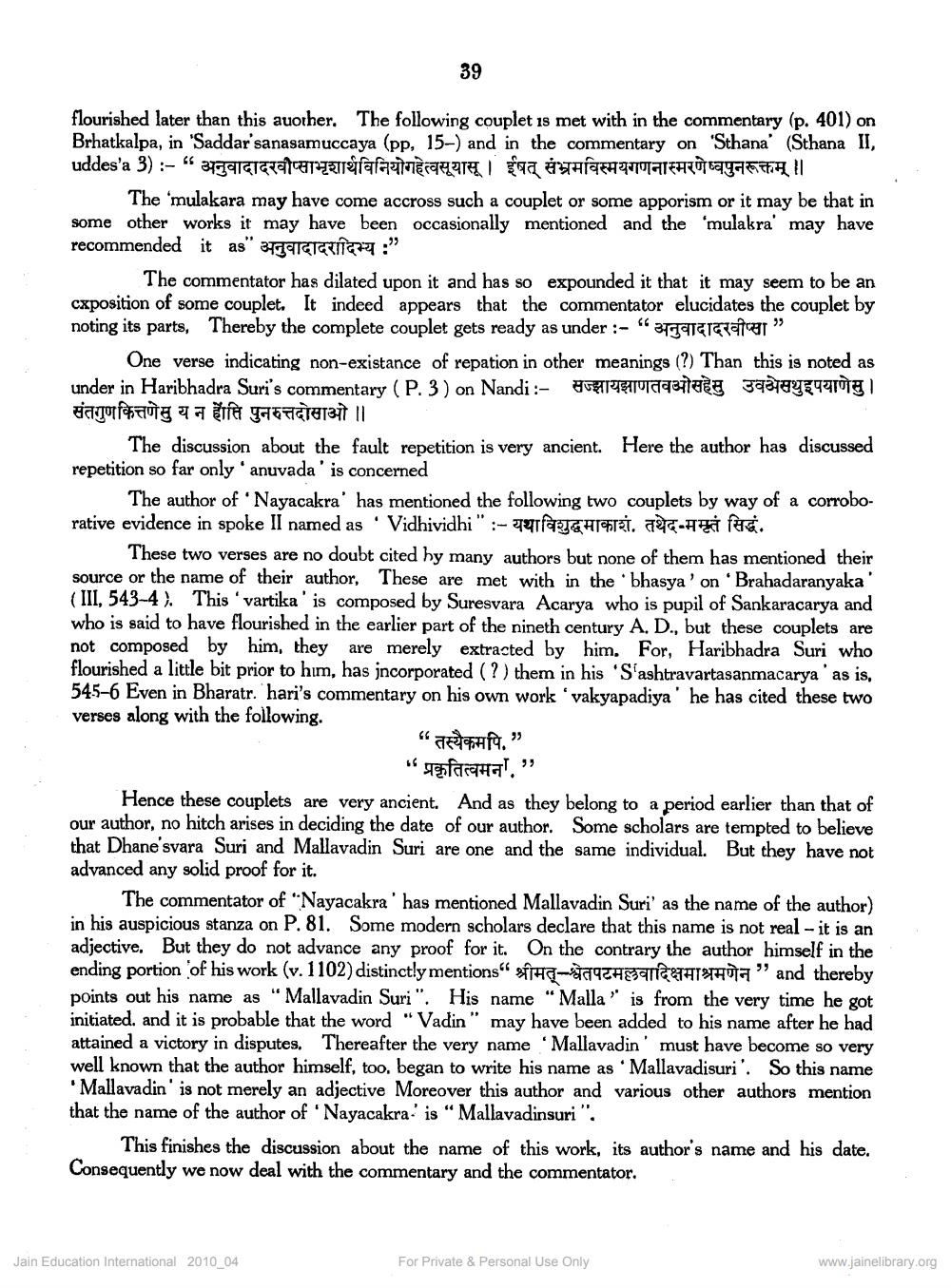________________
39
flourished later than this auother. The following couplet is met with in the commentary (p. 401) on Brhatkalpa, in 'Saddar sanasamuccaya (pp, 15-) and in the commentary on 'Sthana' (Sthana II, uddes'a 3) :-“ 37791giata CATEGCalaimura Te I 90 TAHIMITATEAU SAYA Et !
The 'mulakara may have come accross such a couplet or some apporism or it may be that in some other works it may have been occasionally mentioned and the 'mulakra' may have recommended it as" 34TECTETIT 7 :"
The commentator has dilated upon it and has so expounded it that it may seem to be an cxposition of some couplet. It indeed appears that the commentator elucidates the couplet by noting its parts. Thereby the complete couplet gets ready as under :- "37091araca"
One verse indicating non-existance of repation in other meanings (?) Than this is noted as under in Haribhadra Suri's commentary (P. 3) on Nandi :- 4811481410937a 3981843921181 संतगुणकित्तणेसु य न हॉप्ति पुनरुत्तदोसाओ।
The discussion about the fault repetition is very ancient. Here the author has discussed repetition so far only 'anuvada' is concerned
The author of 'Nayacakra' has mentioned the following two couplets by way of a corroborative evidence in spoke II named as 'Vidhividhi" :- Ghari. 7-ti face.
These two verses are no doubt cited hy many authors but none of them has mentioned their source or the name of their author. These are met with in the .bhasya' on Brahadaranyaka' ( III, 543-4). This 'vartika' is composed by Suresvara Acarya who is pupil of Sankaracarya and who is said to have flourished in the earlier part of the nineth century A. D., but these couplets are not composed by him, they are merely extracted by him. For, Haribhadra Suri who flourished a little bit prior to him, has jncorporated (?) them in his 'S'ashtravartasanmacarya' as is, 545-6 Even in Bharatr. hari's commentary on his own work 'vakyapadiya' he has cited these two verses along with the following.
“a ft.” "
shfaaha!" Hence these couplets are very ancient. And as they belong to a period earlier than that of our author, no hitch arises in deciding the date of our author. Some scholars are tempted to believe that Dhane'svara Suri and Mallavadin Suri are one and the same individual. But they have not advanced any solid proof for it.
The commentator of "Nayacakra' has mentioned Mallavadin Suri' as the name of the author) in his auspicious stanza on P. 81. Some modern scholars declare that this name is not real - it is an adjective. But they do not advance any proof for it. On the contrary the author himself in the ending portion of his work (v. 1102) distinctly mentions" fraa c hen A THO" and thereby points out his name as "Mallavadin Suri". His name "Malla' is from the very time he got initiated, and it is probable that the word " Vadin" may have been added to his name after he had attained a victory in disputes. Thereafter the very name 'Mallavadin' must have become so very well known that the author himself, too, began to write his name as · Mallavadisuri'. So this name 'Mallavadin' is not merely an adjective Moreover this author and various other authors mention that the name of the author of 'Nayacakra.' is “Mallavadinsuri".
This finishes the discussion about the name of this work, its author's name and his date. Consequently we now deal with the commentary and the commentator.
Jain Education International 2010_04
For Private & Personal Use Only
www.jainelibrary.org




